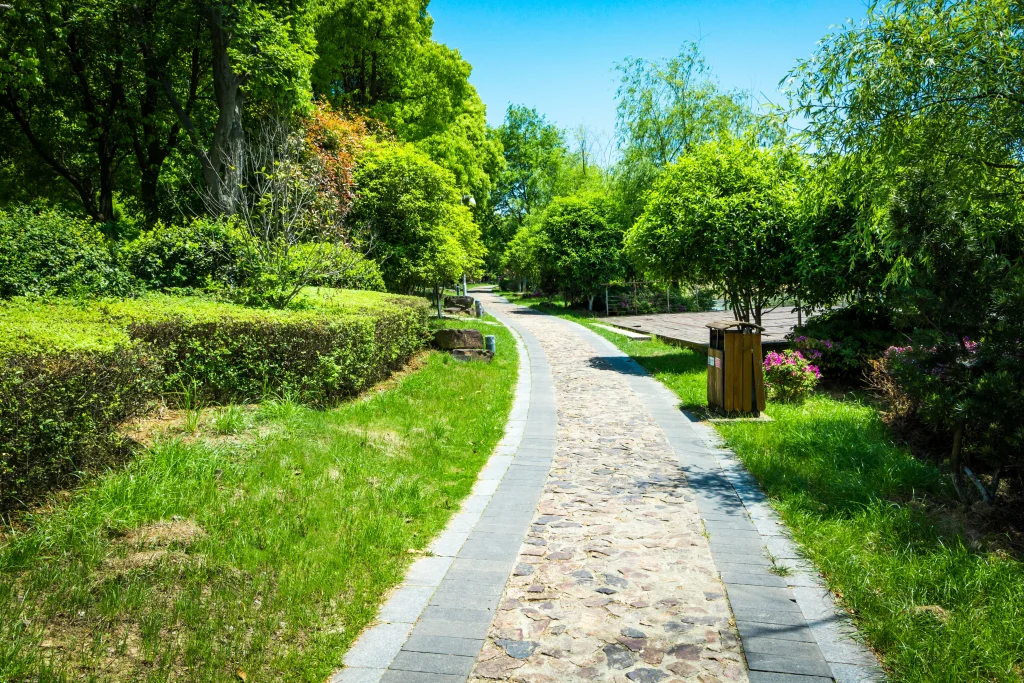How to build a raised flower bed? Building a raised flower bed requires these some essential steps: select location and size, choose materials, gather tools, construct the frame, prepare the base, add soil mix, plant flowers, and apply mulch.
This approach transforms challenging Denver soil into productive growing space that extends your gardening season and reduces maintenance.
In this blog, we provide a comprehensive guide on how to create raised flower beds, benefits and local planting advice. Let’s jump in!
Why Should You Build Raised Garden Beds?
Raised flower beds solve Denver’s most persistent gardening challenges through improved growing conditions and practical benefits.
Drainage improvement
Drainage improvement becomes critical in Colorado’s clay-heavy soils. Native clay holds water longer than plants prefer, creating soggy conditions that kill flower roots.
Raised beds lift plants above this waterlogged soil while allowing excess moisture to drain away naturally. The elevated position prevents root rot and creates healthier growing conditions for delicate flower varieties.
Weed control
Weed control simplifies garden maintenance significantly. Fresh soil mixtures contain fewer weed seeds than existing ground soil. The defined borders make it easier to spot and remove unwanted plants before they establish strong root systems. This controlled environment reduces time spent weeding and increases time enjoying your flowers.
Extended growing seasons
Extended growing seasons provide earlier spring planting opportunities. Raised soil warms faster than ground-level beds because sun exposure reaches the soil from multiple angles.
This earlier warming allows you to plant cold-hardy flowers weeks before traditional beds become workable. Fall growing seasons also extend because elevated soil retains heat longer into autumn.
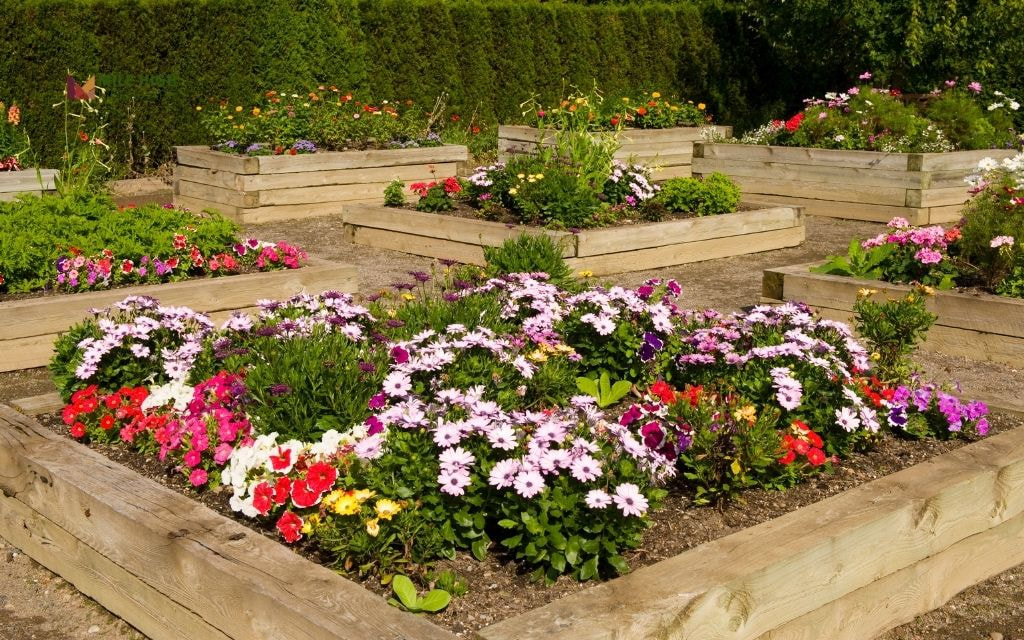
Ergonomic benefits
Ergonomic benefits reduce physical strain during garden maintenance. The elevated height minimizes bending and kneeling required for planting, weeding, and harvesting.
This improved accessibility makes gardening more enjoyable for people with back problems or mobility limitations. Regular maintenance becomes less burdensome when you can reach plants comfortably.
Soil customization
Soil customization allows precise control over growing conditions. You choose exactly what soil mixture goes into your raised bed rather than working with existing clay soil.
This control enables you to create ideal pH levels, drainage characteristics, and nutrient content for specific flower varieties. Different beds can contain different soil mixtures optimized for various plant needs.
Different Kinds of Raised Garden Beds
Framed beds
Framed beds represent the most popular choice for flower gardening.
These structures use wood, metal, or composite materials to create defined borders around elevated soil. Wood frames blend naturally with landscape designs while metal frames provide modern aesthetics and superior durability.
Composite materials offer the appearance of wood with reduced maintenance requirements and longer lifespan.
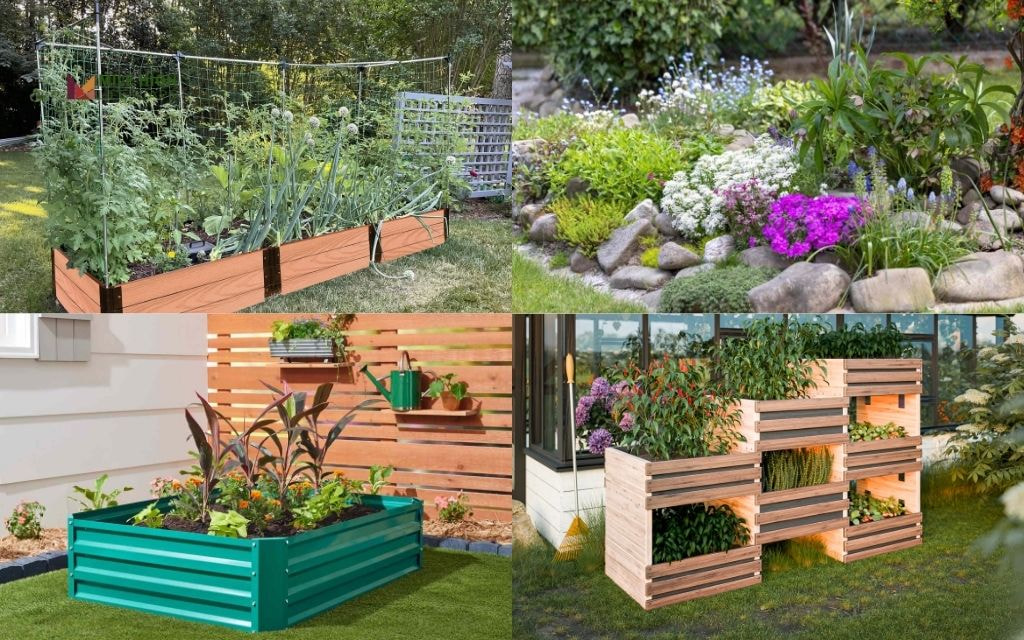
Mounded beds
Mounded beds create raised growing areas without physical frames. Soil gets shaped into raised rows or circles that provide elevation benefits without construction requirements.
This approach works well for informal garden designs or temporary growing areas.
However, mounded beds require regular reshaping as soil settles and erosion occurs over time.
Container-style raised beds
Container-style raised beds suit patios, decks, or small urban spaces perfectly. These portable units function like large planters while providing raised bed benefits.
Many container styles include built-in water reservoirs or drainage systems that optimize growing conditions.
This option allows renters or urban gardeners to create productive flower beds without permanent installation.
Tiered or multi-level beds
Tiered or multi-level beds maximize growing space on sloped properties common throughout Denver neighborhoods.
Multiple raised beds at different elevations create visual interest and provide practical growing areas on challenging terrain.
This design works well for properties with significant grade changes or when you want to create dramatic landscape features.
How to Build a Raised Flower Bed: Step-by-Step Guide
Creating a successful raised flower bed requires careful planning and systematic execution to ensure lasting results in Denver’s challenging climate.
Step 1: Decide on the Location and Size
Select your raised bed location based on sun exposure, accessibility, and practical considerations for long-term success.
- Sun exposure requirements: Most flowering plants require 6-8 hours of direct sunlight daily for optimal blooming. Avoid locations near large trees, buildings, or structures that create shade during peak growing hours.
- Accessibility considerations: Position beds within comfortable reach of water sources to simplify irrigation setup. Ensure clear pathways allow easy access with wheelbarrows, hoses, and gardening tools.
- Size recommendations: Limit bed width to 4 feet maximum so you can reach the center from either side without stepping into the growing area. Length can extend as needed based on available space and desired planting area. Depths between 8-12 inches work well for most flower varieties while remaining manageable for soil filling.
Step 2: Choose the Right Raised Bed Material
Material selection impacts durability, appearance, and long-term maintenance requirements in Colorado’s freeze-thaw climate conditions.
- Cedar wood provides natural rot resistance and an attractive appearance that complements most landscape designs. This softwood contains natural oils that repel insects and resist decay without chemical treatments.
- Composite boards combine recycled materials with binding agents to create durable, low-maintenance options. These engineered materials resist rot, insects, and weather damage while maintaining consistent appearance over time.
- Corrugated steel or galvanized metal creates modern, industrial aesthetics while providing superior durability. Metal materials handle freeze-thaw cycles without cracking or warping that affects wood products. Metal beds typically last decades with minimal maintenance.
- Reclaimed pallets offer budget-friendly options for temporary or experimental beds. Use only heat-treated pallets marked with “HT” stamps to avoid chemical contamination in growing areas.
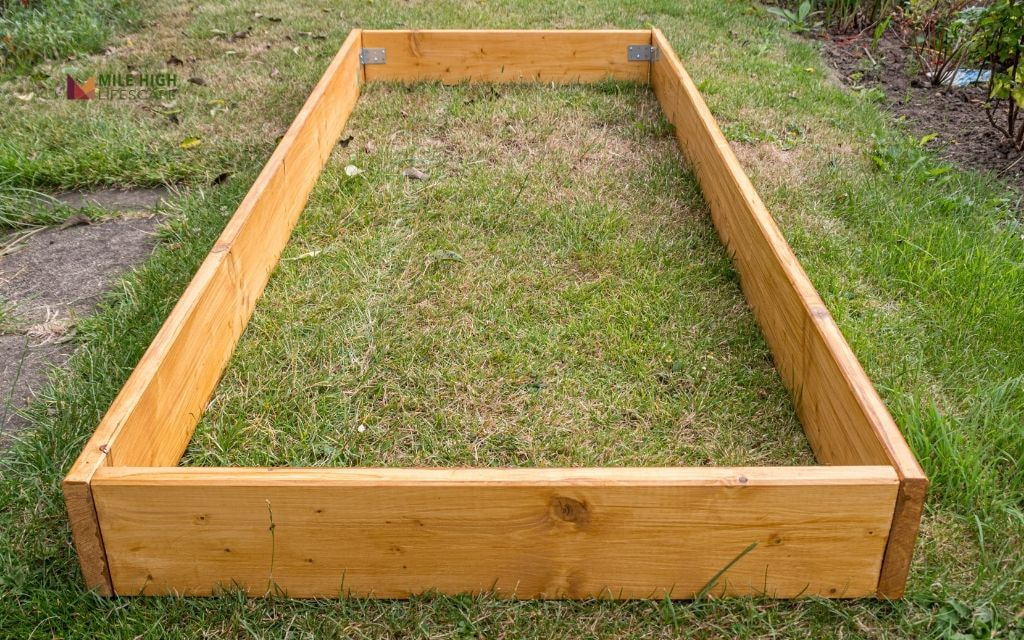
Step 3: Tools and Materials Checklist
Gather necessary tools and materials before beginning construction to ensure smooth, efficient assembly.
Essential tools include:
- Drill with screwdriver bits
- Circular saw for cutting materials to size
- Level for ensuring even construction
- Tape measure for accurate dimensions
- Garden gloves for hand protection
- Wheelbarrows help transport soil and materials efficiently
- Basic hand tools like hammers, screwdrivers, and utility knives,…
Construction materials vary based on chosen bed style and size:
- Purchase boards or panels in appropriate lengths for your design dimensions
- Corner brackets or internal wood stakes provide structural stability and prevent frame separation over time
- Galvanized screws resist rust better than regular screws in outdoor conditions
Soil components form the foundation of growing success:
- Calculate total volume needed by multiplying length times width times depth in feet, then convert to cubic yards.
- Quality topsoil, compost, and drainage amendments create optimal growing conditions for flower varieties.
Step 4: Build the Frame
Frame construction creates the foundation for your raised bed structure and determines long-term stability.
Design planning starts with rectangular shapes that provide maximum growing area with simple construction requirements.
Standard dimensions like 4 feet by 8 feet work well for most locations while using common lumber sizes efficiently. 12-inch depth accommodates most flower root systems while keeping soil volume manageable.
The assembly process begins with pre-drilling holes to prevent wood splitting during screw installation. Position corner brackets or internal stakes to provide structural stability and prevent frame separation. Use galvanized screws that resist rust and corrosion in outdoor conditions. Check corners with a square tool to ensure proper angles and frame stability.
Leveling requirements ensure even water distribution and prevent structural stress. Place the assembled frame on prepared ground and check level with a carpenter’s level.
Adjust by removing soil from high areas or adding soil to low spots until the frame sits evenly. Proper leveling prevents water pooling and frame warping over time.
Step 5: Prepare the Base
Base preparation creates proper drainage and prevents weed competition from below.
- Ground preparation: Remove existing grass and weeds from the area underneath your frame. Use a sharp spade to cut sod into manageable sections for easy removal. Alternatively, place cardboard sheets over grass to create a natural barrier that decomposes over time while blocking weed growth.
- Drainage considerations: Rough up compacted soil with a garden fork or tiller to improve water movement. In severely compacted areas, consider adding a 4-inch layer of coarse gravel before filling with soil mixture.
- Pest protection options include hardware cloth or wire mesh placed at ground level to prevent burrowing animals from accessing plant roots. Quarter-inch mesh blocks most common garden pests like voles and rabbits while allowing beneficial earthworms to move freely. Secure mesh edges to frame sides to prevent gaps that allow pest access.
- Slope adjustments accommodate Denver’s varied terrain and prevent water runoff problems. On sloped ground, level the frame by digging deeper into the high side until both ends sit evenly. This leveling prevents soil and water from washing out the downhill side during heavy rains or irrigation.
Step 6: Add the Ideal Flower Bed Soil Mix for Denver
Soil mixture quality directly impacts flower health, blooming performance, and long-term garden success.
- Recommended proportions for Denver’s semi-arid climate include 40% quality topsoil,40% finished compost, and 20% coarse sand or perlite. This combination provides good drainage while retaining adequate moisture for flower growth.
- Clay soil amendments help native Colorado soil contribute to raised bed success. Add gypsum or expanded shale to heavy clay areas to improve drainage and soil structure. These amendments break up clay particles while adding beneficial minerals that support plant growth. Avoid adding sand directly to clay soil, which creates concrete-like conditions.
- Organic matter importance cannot be overstated for flower bed success. Compost adds nutrients, improves soil structure, and supports beneficial microorganisms that enhance plant health. Well-aged compost from leaves, grass clippings, or mushroom production provides excellent organic matter without burning plant roots. Avoid fresh manure that can damage tender flower plants.
Step 7: Plant Your Raised Flower Bed
Plant selection and arrangement determine visual impact and maintenance requirements throughout the growing season.
- Perennial flowers like blanketflower, catmint, and purple coneflower return annually while requiring minimal maintenance. These hardy varieties tolerate temperature extremes and water limitations common in Colorado’s high-altitude environment.
- Annual flower options provide continuous color throughout the growing season with varieties like marigolds, zinnias, and petunias. Annual flowers require replanting each year but offer flexibility to change color schemes and experiment with different varieties.
- Pollinator-friendly plants support beneficial insects while creating attractive displays. Yarrow, bee balm, and lavender attract butterflies, bees, and other pollinators essential for garden ecosystem health.
Layout strategies maximize visual impact and plant health through proper spacing and arrangement. Place taller flowers toward the back of beds with shorter varieties in front to ensure all plants receive adequate light.
Group plants with similar water and care requirements together to simplify maintenance routines.
Step 8: Mulch, Water & Maintain
Proper maintenance preserves your investment while ensuring continuous flower production throughout the growing season.
- Mulching: Include moisture retention, weed suppression, and soil temperature moderation. Apply 2-3 inches of shredded bark, straw, or decorative rock around plants while keeping mulch away from flower stems. Organic mulches decompose slowly and add nutrients to soil over time.
- Irrigation setup: Install drip irrigation or soaker hoses to deliver water directly to plant roots while minimizing evaporation losses. These efficient systems qualify for Denver Water rebates and reduce water bills while maintaining healthy plants.
- Ongoing care: Include deadheading spent blooms to encourage continued flowering, regular fertilizing during the growing season, and occasional compost additions to maintain soil quality. Monitor for pest problems and address issues promptly before they spread throughout the bed.
- Seasonal maintenance prepares beds for winter and ensures spring success. Cut back perennial flowers after the first hard frost while leaving four to six inches of stem for winter protection. Add fresh compost each spring before new growth begins to replenish nutrients and maintain soil structure.
Explore 20+ beautiful designs for raised flower beds you’ll love in this article.
Bonus: How to Make a Cheap Raised Flower Bed
Reclaimed materials
Reclaimed materials offer significant cost savings while supporting environmental sustainability. Upcycled bricks create permanent borders that require no additional construction while providing excellent drainage and thermal mass. Cinder blocks stack easily and can be rearranged as garden needs change over time.
Free material sources
Free material sources throughout Denver include Resource Central’s salvage operations, where construction materials get diverted from landfills and sold at reduced prices.
Craigslist and Facebook Marketplace often feature free or low-cost lumber from demolition projects. Check with local contractors who may have excess materials from completed projects.
Temporary bed options
Temporary bed options allow experimentation before committing to permanent structures.
Untreated lumber creates functional beds for several growing seasons at minimal cost. Hay bales arrange quickly into raised bed shapes while decomposing into valuable compost over two to three years.
Cost-cutting strategies
Cost-cutting strategies include building smaller beds initially and expanding over time as budget allows. Purchase soil components separately and mix yourself rather than buying pre-made raised bed soil. Start with fewer plants and allow them to spread naturally rather than filling beds completely in the first season.
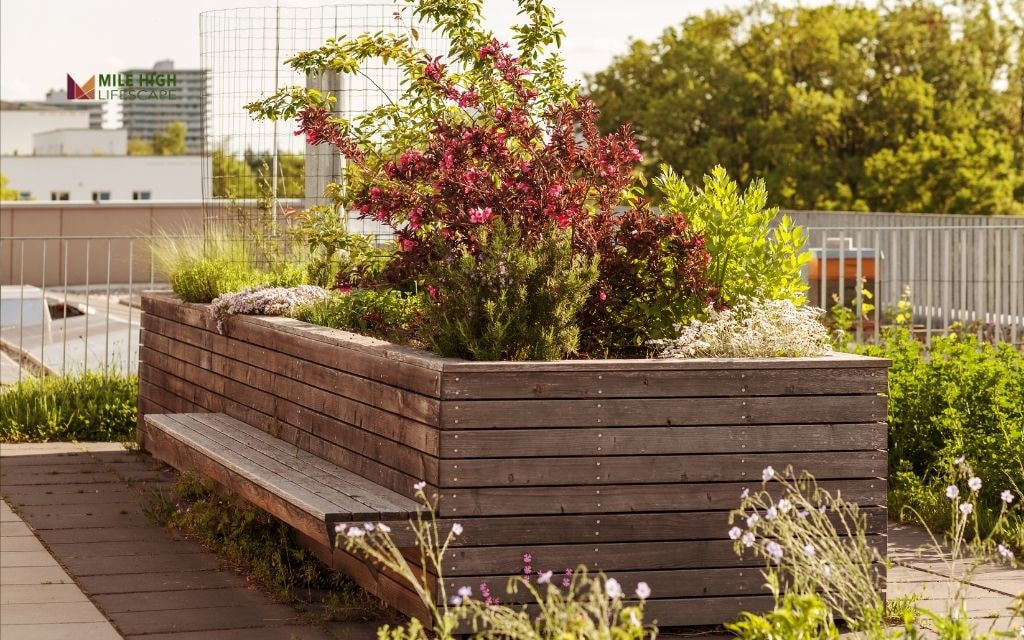
Conclusion
Raised flower beds transform Denver gardening from struggle to success through improved drainage, soil control, and extended growing seasons. These elevated planting areas solve clay soil problems while creating manageable growing spaces that adapt to Colorado’s challenging climate conditions.
For professional flower bed services that integrate seamlessly with your existing landscape design, Mile High Lifescape brings twenty years of Denver-area experience to every project.
Our team understands local soil conditions, climate challenges, and plant selection strategies that ensure your raised flower beds thrive for years to come. Contact us today at (303) 877-9091.
Frequently Asked Questions (FAQs)
How deep should a raised flower bed be?
Most flower varieties thrive in raised beds 8-12 inches deep. This depth accommodates root systems while keeping soil volume manageable for filling and maintenance. Deeper beds require more soil but support larger perennial flowers and provide better insulation against temperature extremes.
Do I need to line the bottom of the raised bed?
No, most raised flower beds perform better without bottom liners that can restrict drainage and root growth. However, add hardware cloth if burrowing pests like voles or gophers cause problems in your area. This wire barrier protects plant roots while allowing beneficial soil organisms to move freely.
Should I leave space between raised beds?
Yes, maintain pathways at least 2 feet wide between raised beds for comfortable access with tools, wheelbarrows, and maintenance equipment. Wider paths accommodate garden carts and provide space for temporary plant containers during bed renovation or seasonal changes.
What is the cheapest way to make raised flower beds?
Reclaimed lumber, cinder blocks, or stacked stones create functional raised beds at minimal cost. Free materials from construction sites, demolition projects, or online classified ads reduce expenses significantly. Start with smaller beds using budget materials and expand as resources allow.
